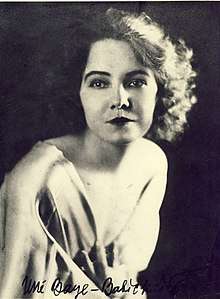Unė Babickaitė
Unė Babickaitė-Graičiūnienė (born Uršulė Babickaitė also known as Une Baye; 19 April 1897 – 1 August 1961)[1] was a Lithuanian actress and theater director. During World War I, she attended the Saint Petersburg Conservatory. After the war, she staged several plays in Lithuania, but they were not well received by the critics. She then moved to the United States and appeared in several silent films. In 1924, she married Vytautas Andrius Graičiūnas. With his financial support, she organized theater plays in Paris and London. Babickaitė returned to Lithuania in 1936. After World War II, she was sentenced to five years in a Gulag.
Unė Babickaitė-Graičiūnienė | |
|---|---|
 Unė Babickaitė - Unė Baye | |
| Born | Uršulė Babickaitė April 19, 1897 |
| Died | 1 August 1961 (aged 64) Kaunas, Lithuanian SSR |
| Other names | Une Baye |
| Alma mater | Saint Petersburg Conservatory |
| Occupation | Actress, theater director |
| Spouse(s) | Vytautas Andrius Graičiūnas |
| Relatives | Petras Babickas (brother) |
Biography
During World War I, Babickaitė and her family retreated to Saint Petersburg. There she met writer Balys Sruoga, who encouraged her to begin theater studies at the Saint Petersburg Conservatory in 1916.[2] Balys named her Unė.[3] After return to Lithuania, she organized theater group Daina and staged several performances.[2] However, a woman director stirred up controversy in a conservative society and the plays were attacked by critics.[3] In 1919, Babickaitė moved to the United States, where she simplified her name to Unė Baye and between 1922 and 1924 appeared in several silent films by Paramount.[4][5] She left the film industry due to a visual impairment and instead performed in the theaters in New York, Washington DC, Chicago.[4]
In 1924, she married Graičiūnas, her cousin, and moved with him to London in 1928.[4] With her husband financing her artistic endeavors,[6] she established the New Russian Theatre, and later the Anglo-American Company Troupe, appeared in theaters in both London and Paris.[4] In France, she met with Konstantin Balmont, who dedicated at least four of his poems to her.[1] Following a serious illness, two car crashes and multiple surgeries, she joined the Third Order of Saint Francis in Italy but did not take vows.[4] In 1936, she returned to Lithuania and directed plays for the Lithuanian Riflemen's Union.[4]
After World War II, the Lithuanian Soviet Socialist Republic became part of the Soviet Union. Her husband, an American citizen, was arrested in 1951 and sentenced to ten years in Gulag. He died the following year under unclear circumstances. Babickaitė was also sentenced to five years.[5] In 1953, during the de-Stalinization campaign after Joseph Stalin's death, she received amnesty and was allowed to return to Lithuania.[5] She died in 1961 in Kaunas.
Legacy
Babickaitė left an extensive collection of documents, correspondence, and photos, which are preserved by the Martynas Mažvydas National Library of Lithuania.[1] Two volumes of documents were published in 2001 and 2005.[6] Various theater exhibits, collected by her, are displayed by the Lithuanian Theatre, Music and Film Museum, established by Balys Sruoga and Vincas Krėvė-Mickevičius in 1926.[7] The family home in Laukminiškės village, where Babickaitė and her brother writer Petras Babickas were born, was turned into an ethnographic and memorial museum in 2002.[8]
References
- "Tarnavusi grožio ir gėrio religijai (Unės Babickaitės-Graičiūnienės 100-ioms gimimo metinėms)" (in Lithuanian). Martynas Mažvydas National Library of Lithuania. 2005-12-16. Retrieved 2010-01-09.
- "Su Une Babickaite - į XX a. pradžią". Verslo žinios (in Lithuanian). 221: 6. 2001-12-07. Archived from the original on 22 July 2011.
- Meškauskaitė, Audronė (2007-12-06). "Paskui skriejančią dvasią". Nemunas (in Lithuanian) (43): 12. Archived from the original on 22 July 2011.
- Cidzikaitė, Dalia (March 23, 2019). "The world was her stage: the extraordinary life and times of Unė Baye". Europeana (CC By-SA). Retrieved 2019-04-30.
- "BABICKAITĖ-GRAIČIŪNIENĖ UNĖ (Une Baye)". Žymūs Kauno žmonės: atminimo įamžinimas (in Lithuanian). Kauno apskrities viešoji biblioteka. 2004.
- "Aktorė Unė Babickaitė-Graičiūnienė apie politiką, teatrą, šeimą ir save" (in Lithuanian). Lietuvos rytas. 2006-07-30.
- Stankevičienė, Janina. "From the Collections of the Theatre, Music and Film Museum from the 19th C to the first half of the 20th C". Lithuanian Theatre, Music and Film Museum. Archived from the original on 11 December 2003. Retrieved 9 January 2010.
- "Laukminiškių kaimo muziejus". Kupiškio etnografijos muziejus. Retrieved 16 February 2019.